We followed Rick Steves advice and headed to the Oslo train station TI (tourist information) booth to get orientated and locate lodging for the night. The college student at the desk booked a room for us at the Albertine Hostel. At $54 per night, Rick said it was the best bargain in a very expensive Oslo.
After a "senior citizen" coke and coffee at the train station McDonalds, we sat outside to people watch and enjoy the city scenes. Sally took this picture of the Bronze tiger "for our granddaughters!" He always seemed to have a child hanging from his tail.
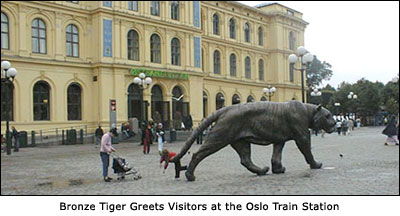
Once again we braved driving in the rain in rush hour traffic to find our hostel after carefully nursing our car out of the haphazard traffic jam in the train station parking lot. We're anxiously waiting to see which one of us is going to put the first scratch or dent on the Volvo – it's going to happen – but when and where?
The Albertine Hostel
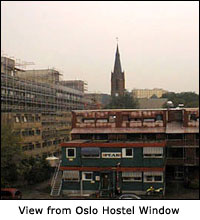
Visualize a bomb shelter – under construction! The whole area, including the hostel, was undergoing major renovation – WHILE STILL OPEN! We were housed on the fourth floor, reached by a metal staircase (like a New York fire escape) or ancient, rickety elevator, take your pick. But we did have a nice room with private bath. And out the back window, we had a great view of the construction site and a church (that's a rooster on the steeple – not a cross)
In the open ledge/hallway in front of our room we practiced being spider man and spider woman. The railing appeared to be for looks since it would not have held up against a small child let alone a senior citizen! Sally insisted they put up a "DO NOT LEAN AGAINST" sign! However the construction crew did not seem to be receptive to her suggestion.
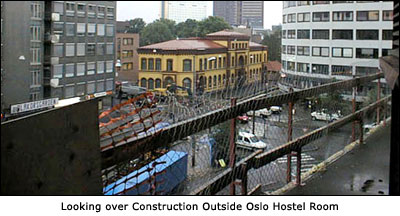
Sailing the Viking Ships
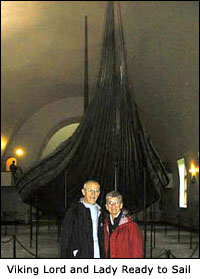
The next morning, we caught the early ferry over to Bygdoy island to do some sight seeing. While in Norway we wanted to check out the Viking ships which we had seen pictures of in National Geographic. Three ships, discovered in 1904, had been either pleasure craft or working ships for their elite Viking owners, until it was time to use them for their burial chambers. Because they were buried in mud for 1200 years, most of their contents were well preserved.
Many items were sent along with the dead for their afterlife: oak chests, horses, pigs, food, cooking pots, leather shoes, dishes, combs, elaborately carved wagons. We marveled at the painstaking process – in the early 1900s – to preserve the wood hulls, and piece them back together to unravel the story buried with the ships over a thousand years ago. We got a glimpse into the life of a Viking person who lived before dresser drawers and leather tanning, but not before combs
Gustav Vigeland 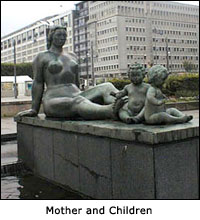
Vigeland sculptures can be seen all over Norway, especially in Oslo. Vigeland made a deal with the city to "beautify Oslo with art" in exchange for a studio and full support for the rest of his creative life. Near this statue, we visited the Oslo City hall, and stood in the same room as Nelson Mandala and Martin Luther King, Jr. when they received their Nobel Peace Prizes. Later we took a guided tour to see the elaborate murals painted throughout the building. What a special treat!
We visited Norway's National Folk Museum, where 150 old Norwegian buildings and houses have been collected and restored. Guides in period costumes demonstrated old crafts: silver smithing, bread baking, weaving etc. In the rugged farm country, the Norwegian women baked "flat bread" only twice a year. It kept very well! We saw many of these log houses with sod roofs throughout Norway.
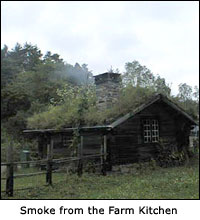 |
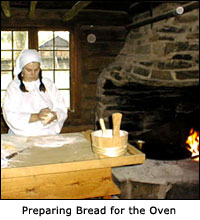 |
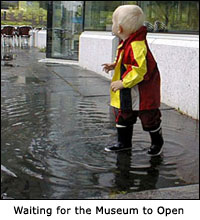
We are surprised by how often we are reminded that children are the same the world over. We watched as this little guy – coaxed by his grandmother – delight in splashing in the puddles outside the Munch Museum while we all waited for the museum to open at 10:00 a.m.
Looking for Stave Churches
Driving through Norway is like driving through one continuous postcard. It cannot be captured in an amateur photo so you'll have to settle for pictures of us eating peanut butter sandwiches by the roadside. Or you can wait until we get home to see the postcards we purchased.
A church steeple peeking out over the trees is enough to cause Sally to lurch the car off the highway and onto a muddy, gravel road. The small country church below, the first of many we saw throughout Norway, was surrounded by headstones, each planted with spring flowers. It was probably built in the 1800s.
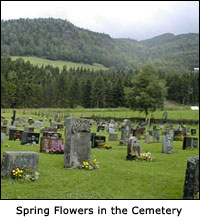 |
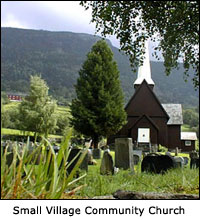 |
We stopped to enjoy the peace and soak up the beauty. We were told by some locals that people don't go to church much anymore except for weddings and funerals. A sunday service might only find a handful of people in one of these lovely churches. None of the churches appeared to have Sunday School facilities for children.
Lunch was easy – peanut butter, fresh bread, local mustard, veggies of all sorts – a spontaneous picnic. Why don't we do this everyday at home? Of course, lunch was just an excuse to get ready for our afternoon treat – a Norwegian waffle piled high with fresh strawberry jam and rich country cream (sometimes we forget that we are vegan).
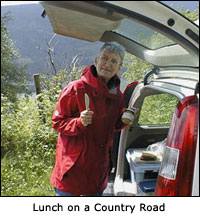 |
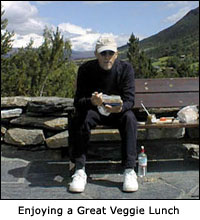 |
We often spotted housewives or kids by the roadside selling fresh strawberries, and resisted, thinking they must be like the chemical laden strawberries at home. Finally, we succumbed, and ate the sweetest berries we've ever tasted – grown without pesticides the vendors told us. (Those harsh chemicals apparently aren't legal here.) The berries were at the peak of the season, and we ate them daily for our vitamin C!
On to Troll Country
This is the Norway we envisioned: green, green, green, wild flowers everywhere, red barns, slate roofs, water rushing off mountains, waterfalls and rivers. Bill put on a CD and beautiful, medieval chanting music surrounded us. We were off to see our first Stave church – built after the Vikings, in the 1100s. We first learned about these special buildings at the Norway exhibit at Disney World Showcase in Orlando. What a treat to visit the real thing. Disney "imagineering" doesn't come close to capturing reality!
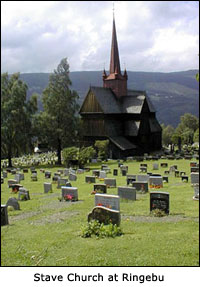
We missed the turn off for the church, but a local gave us directions for the back route, "Oh, then you'll see the view!" Up, up, up we climbed with breathtaking views of the valley and river in both directions. Sally held onto the dash board as Bill maneuvered the car along the steep, narrow road.
Over the hill, suddenly, there it was! Our first Stave church built at the end of the twelfth century. It was more beautiful than the book photo, rich dark vertical timbers wet from the recent rains, surrounded by a graveyard where each headstone was graced by freshly planted spring flowers.
Ringebu Church
A local man cut through the graveyard via a small wooden gate. We followed only to discover that we had come upon a funeral, and the Stave church was closed to the public. (Then we saw the tour bus waiting at the main gate.) We found ourselves standing at the entrance of the church as the local villagers – all dressed in black finery – somberly greeted each other and entered the church.
Inside the church was lit with candles, and the casket was in the center aisle covered with flowers. A beautiful, beautiful scene. We humbly stood outside, Sally in her red rain coat, and Bill – closer to funeral attire in a dark navy rain coat – but wearing jeans. We hung our heads and nodded to those arriving until we could sneak out and take our leave. The scene reminded Sally of another favorite movie, "Waking Ned Devine."
As we took our leave down the path and out the main gate, we saw the sign written in Norwegian, German and English: "Closed Today – Funeral." Two guides, dressed in period costume, sat outside the gate. Bill commented on the large number of people attending the funeral. We asked "Why are the flags at half-mast in the village. Was he an important dignitary?" The guide said, "He was a very old man who had many friends and relatives. When anyone dies in our community, we put the flags at half mast." Imagine, a community where everyone matters. We had lunch just up the road from the church at a picnic table where we could "see the view." We love Norway!
Heading for the High Country
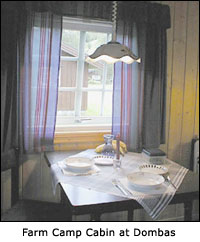
We stayed in a cabin in the middle of a lush, green farm field. The proprietor, Ann-Marie, said "It has rained everyday for 45 days." She went on to say " . . . crops are reduced and the cows will get 'slim' this winter . . ." We were reminded of the difficulties faced by the small family farmer. One reason Norway has not joined the European Union is that it would encourage big agribusiness and hasten the demise of their small family farms.
The Europeans are great campers, many pulling modest trailers or RVs – not the humongous road and gas hogs so prevalent in the states. Throughout Europe there are many campgrounds with cabins or cottages for rent. They are inexpensive (around $35-45 at the 2002 exchange rate) and are fully equipped with dishes, cooking facilities, showers, and barbecues – all geared for traveling families.
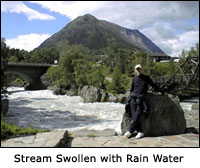
We decided to detour 80 miles to see the Lom Stave church, dating from the 1100s. We were disappointed to discover hundreds of people and their tour buses, vendors hawking trinkets, and a traffic jam. The poor church looked worn out. Nearby Bill discovered a foot bridge crossing a rushing river. We found a peaceful spot, ate some strawberries, and tried to spot the Troll who lives in the mountain behind Bill in the photo.
The Toll Road?
Heading north we again took the advice of a local, and chose a "shortcut" over the mountain. "It's a good road, how you say . . . gravel?" Since it was a toll road, we thought it's got to be a good one, like the New Jersey Turnpike – that's a toll road. Right? – Wrong!
We headed up, up the twisting, narrow dirt and gravel road. The toll (you stop and put coins in an envelope) must be to pay for helicopter service to remove tourists who get stuck up there! Soon we were all alone up above the tree line in the wilds of Norway. What spectacular views as an expansive plateau of tundra and slate opened up. A herd of cows meandered across the road, then some sheep, their bells clanging in the silence. Water falls were everywhere. The terrain was rocky, craggy, quiet. We loved it.
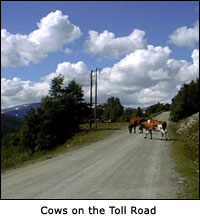 |
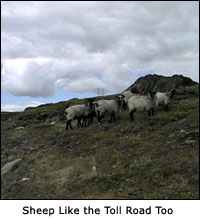 |
We occasionally passed a small cottage, built by farmers for summer use while tending their herds. We came across strange stacks of rocks and wondered what they were – ancient native shrines? Sheep herder communication?
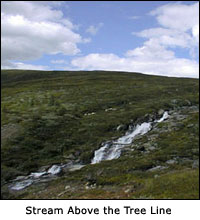
No, on second thought, they were a fun diversion for campers who brave these roads, rather like those we occasionally see along West Cliff Drive in Santa Cruz. We finally descended into a green farm valley and headed toward the coast and the fjords.
2002 was designated the International Mountain Year by the United Nations: "Remember that nature experiences and the simple outdoor life are promoted through play and activities and are intended to create enduring, positive attitudes."
Our adventure on the Toll Road above the tree line imbued our spirit with a sense of the enduring beauty of our planet and how blessed we are to enjoy it.
| Veggie Gram Menu | Next Veggie Gram |